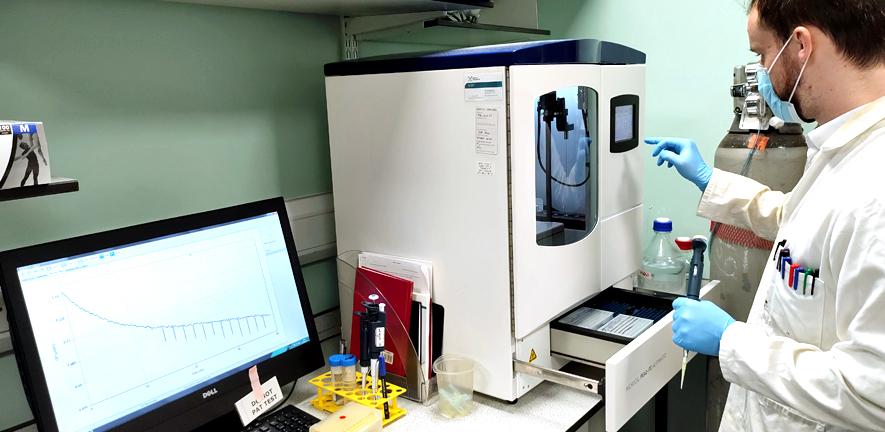
Isothermal titration calorimetry (ITC) is a quantitative technique that measures the thermodynamics of binding between purified biomolecules and/or chemicals in their near-native states, by measuring the heat released or absorbed as the binding event occurs in solution. The binding parameters measured include binding constant (KD in µM - nM range), stoichiometry (n as a molar ratio), enthalpy change (ΔH), and entropy change (ΔS). The results not only give an accurate estimation of the binding affinity but also reveal insights the mechanism of binding via the thermodynamic characterisation.
The Biomedical Isothermal Titration Calorimetry Facility is located in the Division of Virology at Addenbrooke’s Hospital. It has a fully automated MicroCal PEAQ-ITC instrument (Malvern Panalytical) capable of performing ITC experiments with automated cell cleaning and minimal manual handling. Multiple experiments can be set up to run automatically over the course of a few hours to days.
Sample requirements
- Titrant (sample in the syringe, high concentration) A minimum of 120 µL is required per experiment. Titrant usually needs to be approx. 10 times more concentrated than titrate. If KD of the reaction is completely unknown, try 300 µM for a first attempt.
- Titrate (sample in the cell, low concentration) A minimum of 380 µL is required per experiment. Titrate usually needs to be approx. 10 times less concentrated than titrant. If KD of the reaction is completely unknown, try 30 µM for a first attempt.
- Both titrant and titrate need to be in the exact same buffer. This can be achieved either by exhaustive dialysis against the exact same reaction buffer (same beaker for dialysis) or by running both samples through a size-exclusion column in the exact same reaction buffer (same bottle of buffer).
- Both samples need to be degassed prior to experiments. A degassing station can be found next to the ITC machine.
Buffer requirements
Phosphate/citrate buffers are preferred as they have a low heat (enthalpy) of ionisation. Buffers with large enthalpies of ionization, e.g. Tris and HEPES, are less favourable but can be used if necessary. If a reducing agent is required, TCEP is preferred over β-mecaptoethanol and DTT is the least favourable. It is important to make sure that your protein is stable and monodisperse in the chosen buffer!
Usage charges
The current cost of using the machine is £150 per day for University of Cambridge and £250 per day (plus VAT) for other UK Universities/institutions, which includes all consumables. Access prices for commercial users is available upon request.
Finding the facility
The Biomedical Isothermal Titration Calorimetry Facility is located in the Division of Virology, which is situated on level 5 of the Labs Block at Addenbrooke’s Hospital. See the University map for details.
Contact details
Please email Dr Stephen Graham (scg34@cam.ac.uk) if you are interested in using the facility.
This instrument is highly automated and optimised for unattended data collection of multiple samples. The facility offers access to the instrument and analysis software but does not have the capacity to provide extensive assistance with experiment design. If you are new to ITC (or biophysics in general) we suggest you contact the Biophysics Facility in the Department of Biochemistry
Directors of the Biomedical Isothermal Titration Calorimetry Facility
Dr Stephen Graham: scg34@cam.ac.uk
Professor Ian Brierley: ib103@cam.ac.uk

